Japanese yen is trading lower.
On Tuesday, the Japanese yen (JPY) fell against the US dollar for the second day in a row. Traders wary ahead of the Bank of Japan’s (BoJ) policy meeting on Wednesday. Which may result in a rate hike. Market speculate that the BoJ may raise rates by 10 basis points to 0.1% and largely expected to announce its
Bond buy tapering strategies.
The Bank of Japan is largely predicted to increase interest rates by ten basis points.
Japan’s Chief Cabinet Secretary, Yoshimasa Hayashi, announced on Tuesday. That the Bank of Japan and the government will work closely together, but the intricacies of monetary policy will remain the BoJ’s responsibility. Hayashi highlighte that the BoJ will work closely. With the government to execute appropriate monetary policies aimed at meeting the inflation objective.
The CME FedWatch Tool predicts a 100% chance of at least a 25 basis point Fed rate drop in September.
The US dollar may face problems as the US Federal Reserve (Fed) is expected to leave interest rates steady on Wednesday. However, traders predict a Fed rate decrease in September, with the CME FedWatch Tool indicating a 100% chance of at least a quarter percentage point reduction. Furthermore, indicators of cooling inflation and easing labor market conditions in the United States have spurred predictions for three rate reduction by the Fed this year.
Daily Market Movers: Japanese Yen drops amid hawkish sentiment surrounding the BoJ.
Japan’s unemployment rate was 2.5% in June, slightly lower than market expectations of 2.6% and the four-month average. This represents the lowest unemployment rate since January.
Japan’s top council has encouraged the government and the Bank of Japan to consider the weak JPY when developing policy. The council highlighte that the impact of a weaker yen and increased prices on consumption cannot be ignored.
Reuters has published an in-depth report on the Bank of Japan’s (BoJ) examination of previous policy, noting a dramatic shift in the central bank’s approach to inflation. The main message of the review is that Japan is “ready.” “For higher rates.” However, the evaluation will not result in any modifications to the price target or policy framework.
US Personal Consumption Expenditures (PCE) Price Index climbed 2.5% year on year in June.
On Friday, the US Personal Consumption Expenditures (PCE) Price Index climbed 2.5% year on year in June, down slightly from 2.6% in May, meeting market forecasts. On a monthly basis, the PCE Price Index climbed by 0.1% after remaining constant in May.
Masato Kanda, Japan’s senior currency ambassador, told the G20 on Friday that foreign exchange (FX) volatility hurts the Japanese economy. Kanda acknowledged a growing chance of a gentle landing and emphasized the importance of continuously monitoring the economy and implementing required measures, according to Reuters.
According to Bank of America, strong economic growth in the United States enables the Federal Open Market Committee to “Afford to Wait” before making any modifications. According to the bank, the economy “remains on robust footing” and that the Fed will begin decreasing rates in December.
The BlackRock Investment Institute stated in its mid-year outlook that Japan’s Bank of Japan will not hike interest rates at its meeting next week. Furthermore, JP Morgan anticipates that the Bank of Japan (BoJ) will not raise interest rates in July or at any other time in 2024.









